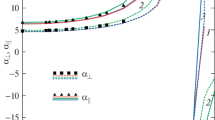Abstract
The relaxation patterns around isovalent substituent atoms in the NaCl, CsCl, ZnS, CaF2, Li2O, and ReO3 structure types have been calculated. Such models (1) emphasize geometric structural criteria and are thus conceptually simple, (2) are computationally straightforward though perhaps computer-time consuming for large, low symmetry cases, and (3) agree reasonably well with more complex calculations, such as energy minimization methods. On the basis of such optimum interatomic distance models, atomic displacements resulting from an isovalent substitution: (1) depend strongly on the structural connectivity (structural type) involved, (2) are decidedly greater for atoms with radius vectors parallel to the substituent's bonds and least for atoms with radius vectors oriented between such bonds, (3) decrease in magnitude approximately inversely proportional to the square of the distance to the substituent, regardless of direction, and (4) are mostly, but not strictly, radial. The simplest relationship to structural type is the dependence on the coordination of the substituent's ligands — the greater the coordination number of the atoms bonded to the substituting atom, the less compliant the structure.
Similar content being viewed by others
References
Baur, W.H.: Computer simulation of crystal structures. Phys. Chem. Minerals 2, 3–20 (1977)
Catlow, C.R., Diller, K.M., Norgett, M.J., Corish, J., Parker, B.M., Jacobs, P.W.: Off-center displacements of univalent impurity ions in alkali halide crystals. Phys. Rev. Sect. B18, 2739–2749 (1978)
Dempsey, M.J., Strens, R.G.: Modelling crystal structures. In: Physics and chemistry of minerals and rocks, Strens, R.G. (ed.) London: J. Wiley & Sons, 1976
Eshelby, J.D.: The continuum theory of lattice defects. Solid State Phys. 3, 79–114 (1956)
Flinn, P.A., Maradudin, A.A.: Distortion of crystals by point defects. Ann. Phys. 18, 81–109 (1962)
Flynn, C.P.: Point defects and diffusion. Oxford: Clarendon Press, 1972
Fukai, Y.: Lattice distortion around impurity ions in alkali halide crystals II. Quadrupolar broadening of nuclear magnetic resonance lines. J. Phys. Soc. Jpn. 18, 1580–1589 (1963)
Hardy, J.R.: A theoretical study of point defects in the rocksalt structure. Substitutional K+ in NaCl. J. Phys. Chem. Solids 15, 39–49 (1960)
Hardy, J.R.: The effect of ionic polarization on the lattice distortion produced by a substitutional K+ ion in NaCl. J. Phys. Chem. Solids 23, 123–116 (1962)
Onuki, H., Ernst, W.G.: Coexisting sodic amphiboles and sodic pyroxenes from blueschist facies metamorphic rocks. Mineral. Soc. Am. Spec. Pap. 2, 241–250 (1969)
Author information
Authors and Affiliations
Rights and permissions
About this article
Cite this article
Dollase, W.A. Optimum distance model of relaxation around substitutional defects. Phys Chem Minerals 6, 295–304 (1980). https://doi.org/10.1007/BF00307619
Received:
Issue Date:
DOI: https://doi.org/10.1007/BF00307619




